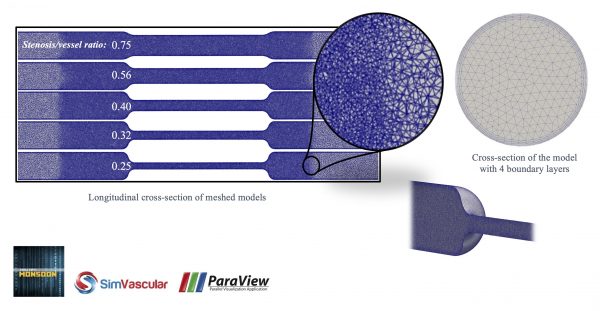Computational fluid dynamic (CFD)

We emphasize modeling of novel endovascular devices can be designed and optimized utilizing computational fluid dynamic (CFD) as well as benchtop testing techniques to create and test prototypes that maximizes blood flow perfusion past the device during device placement and minimizes flow into the aneurysm by protecting the aneurysm neck.
- Computational fluid dynamics modeling (CFD). Device designs are modeled based on a device designs
- According to the literature, pulsatile flow waveforms are prescribed for vessel inlets
- High-resolution hemodynamic can be obtained by solving the Navier-Stokes equation with SimVascular software
- Monsoon®, NAU’s high-performance computing cluster, is utilized to perform the simulations
- Bench-top testing. BDL team have developed sophisticated 3D-printed in vitro vessel models that are controlled by a programmable, digitally controlled hydraulic pulsatile pump (SuperPump AR, ViVitro Labs)
- Blood analog exits the programmable pump, enters the vessel model, and returns to the pump
- With the help of real-time pressure data, the model function has been validated
- Comparison can be made between real-time pressure and flow data resulting from bench-top tests and CFD results
Methods offers a safer and non-invasive alternative to invasive measurements, making it a promising technique for clinical use. Additionally, it has the potential to provide more detailed information about the blood flow and its changes in response to stenosis, which may not be possible with invasive methods. Although numerical techniques such as computational fluid dynamics (CFD) have been utilized in numerous studies to investigate the hemodynamics of vessels, very few studies have comprehensively assessed the hemodynamics of vessels in a real physiological representative environment.
Through theoretical estimation, CFD modeling, and utilization of an advanced bench-top system, we can explore the complex dynamics of blood flow within stenosed vessels. These various methods allowed us to understand the pressure-drop phenomena, flow characteristics, and device performance, revealing the complex interaction between vessel geometry, blood viscosity, and resistance.
- CFDl equipment
- MONSOON – High performance computing cluster (4076 cores, 26TB memory, and 27 NVIDIA GPUs)
- Dual Monitor Dell i9-14900K, 24 Core, 64 GB Ram, 6.0 GHz desktop computer
- Mac Studio – Apple M1 max chip, 10 Core, 32 GB Ram
- Dual Monitor Dell i7 Eight Core, 48 GB Ram, 4.8GHz desktop computer
- CFD software
- ANSYS
- MATLAB
- Solidworks
- SimVascular
- ParaView